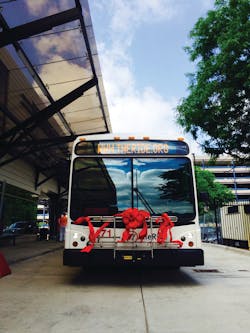MI: Grand Opening Ceremony Celebrates AAATA’s New and Improved Downtown Blake Transit Center
The Ann Arbor Area Transportation Authority (AAATA) July 7 held a grand opening ceremony attended by U.S. Rep John Dingell, Ann Arbor Mayor John Hieftje, federal authorities, state officials and local civic leaders to officially unveil the new and improved downtown Blake Transit Center.
“Today’s grand opening builds on Ann Arbor’s legacy as the home of one of Michigan’s most efficient, effective and environmentally friendly public transit services,” said AAATA CEO Michael Ford.
“The Blake Transit Center will help to improve the quality of life in Washtenaw County by providing residents with a modern, clean and visually appealing structure that will better accommodate riders, embrace new eco-friendly technologies and enhance the public transit customer experience,” Ford said.
The $8.1 million project included demolition of the existing one-story building at 331 S. Fourth Ave. and constructing a new two-story Blake Transit Center that will serve as the AAATA’s main downtown hub. The center is located midblock between Fourth and Fifth avenues, north of William and south of the federal building.
July 7’s grand opening ceremony was attended by numerous governmental officials. Also in attendance was special guest Rosemarion A. Blake of Ann Arbor, the widow of longtime AAATA marketing director Richard D. Blake, in whose honor the transit center building was dedicated after he died in 1989.
“This facility signals the beginning of an exciting new chapter in the AAATA’s history of success and would not be possible without the strong leadership and vision of the entire AAATA team,” said Mayor Hieftje. “The AAATA management and staff deserve credit for skillfully putting together the talent and resources toward a project that is essential to our community’s current prosperity and future growth.”
The new 12,019-square-foot building includes space for a main customer service lobby, accessible restrooms, offices for AAATA and getDowntown staff, conference rooms, a staff break room, and a basement for storage and mechanical equipment. A high canopy of steel and tinted glass runs along the northern side of the building. Bike parking and benches are included on the site, and bus stops along Fourth Avenue were redesigned as part of the project.
“The opening of a new Blake Transit Center is good for people, good for our community and good for business,” said Nancy Shore, director of Ann Arbor’s getDowntown Program. “We can all take pride that AAATA and Ann Arbor are recognized as national leaders in attracting people from all walks of life to enjoy the benefits of public transportation.”
AAATA Board Chair Charles Griffith said he is especially pleased the architectural and engineering designs ensured AAATA’s new center features LEED Gold certification from the U.S. Green Building Council for environmental excellence. The new facility’s design also complies with guidelines required under the Americans with Disabilities Act (ADA), in contrast with the previous structure.
“AAATA’s commitment to policies that protect our health, as well as promote independence and access to transportation choices.stablished,” Griffith said. “The new Blake Transit Center design incorporates several sustainability features that continue AAATA’s superior record of environmental stewardship and quality service to all residents of our community.”
Roof storm water runoff, for example, will be collected for “gray water” use, such as flushing toilets. Materials from the former transit center building were recycled and used in the new facility’s construction. The site also includes a snowmelt system that heats the driveway and sidewalks to melt snow, which reduces the amount of plowing and salt that’s needed. This state-of-the-art approach reduces wear and tear on the driveway and lessens the amount of salt discharged into the storm water system, Griffith noted.
Another highlight of the new Blake Transit Center project is that it’s the first time AAATA has successfully utilized federal Disadvantaged Business Enterprise (DBE) and Small Business Enterprise (SBE) programs, which foster growth in local economies by providing opportunities for small businesses and firms owned by women and minorities.
The federal programs are applicable to contracts administered by local municipalities and transit authorities but paid for, in part or wholly, by federal funds from the U.S. Department of Transportation (USDOT). AAATA utilized transit center-related contracts with area small businesses totaling $1.1 million, exceeding the standard federal goal of 10 percent of total project cost by $300,000. DBE and SBE companies that AAATA partnered with on the project include Blaze Contracting Inc., a Detroit excavation company, and Bailey-Labelle, a Detroit-based electrical contracting joint venture.
“A strong public transportation system is critical for economic development when businesses look to locate in Ann Arbor and throughout the Washtenaw County area,” said Ann Arbor Downtown Development Authority (DDA) Executive Director Susan Pollay.
“People who ride AAATA most often are traveling to spend money or make money, and bus service is the key that connects passengers to pockets of prosperity,” Pollay said. “For all these reasons, we need to keep public transportation strong, and the Blake Transit Center project will help to achieve that objective.”
The $8.1 million estimated cost of the project exceeds original estimates based on additional needs identified through community input during public hearings and environmental analysis, as well as the costs of the city’s approval process. More than $7 million of the total project costs are funded through state and federal grants that were earmarked for the creation of the new transit center.
The new Blake Transit Center is necessary to meet growing passenger demands for AAATA services based on data that shows:
Ridership has increased more than 88 percent since the mid-1908s, with more than 5,000 riders daily arriving and departing through the Blake.
Bus traffic has also increased, with an hourly average of about 40 buses accessing the facility. Approximately 1.5 million people now use the Blake Transit Center annually.
Projected future ridership increases that AAATA and Washtenaw County officials anticipate will come when AAATA introduces new and expanded transit services in Ann Arbor, Ypsilanti and Ypsilanti Township beginning in August.
